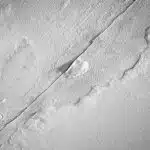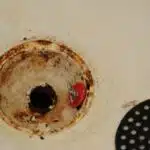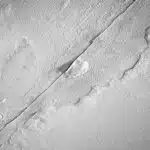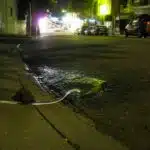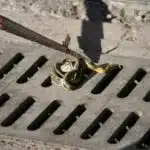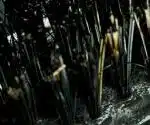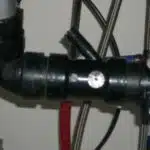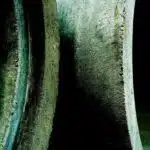As a plumbing and drainage expert, one of the most common issues I’ve encountered is hair clogging up bathtub drains. This problem is not only frustrating for homeowners but can also lead to long-term damage to their plumbing systems. Hair buildup in the drain can cause water to drain slowly or even become completely blocked, resulting in standing water, bad odors, and potential flooding.
However, removing hair from a bathtub drain doesn’t have to be a difficult task. With the right tools and techniques, anyone can successfully clear out their drain and prevent future clogs. In this article, I will share my expertise on how to get hair out of a bathtub drain effectively and efficiently. Whether you are dealing with a minor blockage or a more severe issue, I am confident that these tips will help you restore your plumbing system’s functionality and keep your drains flowing smoothly for years to come.
Signs Of A Clogged Bathtub Drain
Identifying hair buildup in bathtub drains is a common plumbing issue that most homeowners face. A clogged drain can prevent the water from flowing freely, causing it to back up and flood the bathroom. If you notice that the water is draining slowly or not at all, then there may be a hair buildup in the drain.
Preventative measures for hair clogs include using a hair catcher or strainer over the drain to catch loose hairs before they go down the drain. You can also try using vinegar and baking soda to dissolve any existing hair buildup in your pipes. Avoid pouring grease or oil down the drain as these can also contribute to clogs.
Understanding how hair gets stuck in drains is crucial in preventing future blockages. When you wash your hair, small strands inevitably fall out and get trapped in the pipes over time. Other factors such as soap scum and mineral deposits can also contribute to clogs. By being proactive with preventative measures, you can avoid costly repairs and keep your bathtub drain flowing smoothly.
Understanding How Hair Gets Stuck In Drains
Signs of a clogged bathtub drain can be frustrating to deal with, especially when you’re in a hurry. One of the most common causes of clogs is hair buildup, which can accumulate over time and eventually block the drainage system. Understanding how hair gets stuck in drains and taking preventative measures can help you avoid this problem.
Hair has a tendency to cling onto surfaces due to its texture and structure. When it comes into contact with soap or other products, it creates a sticky mass that can immobilize anything that passes through the drain. This leads to gradual accumulation of hair over time, which ultimately results in clogs. Preventing hair from entering your drain in the first place is key to avoiding these issues.
One way to prevent hair buildup is by using a strainer or filter over your drain. These devices catch any loose hairs before they have a chance to go down the drain and cause problems. Additionally, making sure you clean out your drain on a regular basis can also help in preventing clogs caused by hair build-up. By following these simple steps, you can keep your bathtub running smoothly for years to come.
To effectively remove hair from your bathtub drain, there are basic tools that you will need. These tools include gloves, pliers, needle-nose pliers or tweezers, and possibly a plumbing snake if the blockage is severe. Gloves are important because they protect your hands from bacteria and other harmful substances that may be present in the pipes. Pliers allow you to easily grasp larger clumps of hair and pull them out of the drain while needle-nose pliers or tweezers are perfect for removing smaller pieces of debris that may be stuck deeper within the pipe system. With these tools at hand, removing hair from your bathtub drain will be an easy process that won’t require any professional assistance.
Basic Tools For Removing Hair From Drains
To remove hair from a bathtub drain, you will need the appropriate tools for the job. These tools include a plunger, a drain snake, and a pair of needle-nose pliers. The plunger is particularly effective at removing hair that has not yet formed a complete blockage in the drain. To use the plunger, apply downward pressure and then pull it up quickly to create suction.
For more stubborn blockages, a drain snake may be necessary. This tool is inserted into the drain and used to break up or remove any clogs that may be present. When using a drain snake, it is important to work slowly and carefully to avoid causing damage to the pipes.
In addition to using the appropriate tools for unclogging drains, it is important to follow best practices for maintaining drains in order to prevent future clogs. This includes regularly cleaning out debris from sink and bathtub drains, avoiding pouring grease or oil down drains, and using screens or strainers over drains to catch hair and other debris before they have a chance to enter the pipe.
Transition: While basic tools are essential for removing hair from drains effectively, there are also various homemade drain cleaners that can be just as effective when dealing with clogged pipes.
Homemade Drain Cleaners And Their Effectiveness
DIY drain cleaning has become a popular trend among homeowners who want to save money on plumbing services. While there are many natural drain cleaning solutions available, not all of them are effective in clearing the blockage in your drain. In fact, some DIY techniques can even worsen the problem and cause more damage to your pipes.
One of the most common natural drain cleaning solutions is baking soda and vinegar. This mixture is said to create a foaming reaction that helps break down the clog in your drain. However, this method only works for minor blockages and may not be effective for larger obstructions. Additionally, using too much of these ingredients can corrode your pipes over time.
Another popular DIY drain cleaning solution is using a plunger. While plungers can be effective for minor clogs, they are not recommended for major blockages or if you suspect that the obstruction is caused by an object stuck in your drain. Using a plunger incorrectly can also cause damage to your pipes and lead to further problems.
In conclusion, while DIY drain cleaning may seem like an easy and cost-effective solution, it is important to understand its limitations and potential risks. Natural drain cleaning solutions like baking soda and vinegar or plungers may work for minor clogs but should be used with caution. For major blockages or suspected pipe damage, it is best to seek professional plumbing services to prevent further damage and ensure proper maintenance of your drainage system.
Moving forward, regular maintenance of your drainage system is crucial in preventing future clogs and damages. In the next section, we will discuss the importance of regular maintenance and how it can benefit homeowners in keeping their drains clear and functional.
The Importance Of Regular Maintenance
Every homeowner knows that regular maintenance is key to keeping their house in top shape. And when it comes to plumbing and drainage, this couldn’t be more true. The importance of regular maintenance cannot be overstated when it comes to preventing clogs and other plumbing issues.
Prevention is the name of the game when it comes to maintaining your home’s plumbing and drainage systems. By taking proactive steps to prevent clogs, you can save yourself a lot of time, money, and headaches down the road. This means being mindful of what goes down your drains, using drain covers or screens to catch hair and other debris, and scheduling regular professional inspections.
Regular maintenance not only helps prevent clogs but also ensures that your plumbing and drainage systems are working efficiently. Over time, mineral buildup can occur in pipes and fixtures, which can lead to reduced water flow and even leaks. By having your pipes professionally cleaned on a regular basis, you can ensure that they stay clear and functioning properly for many years to come.
With the importance of regular maintenance established, let’s move on to how you can effectively remove hair from bathtub drains using a plunger.
Removing Hair With A Plunger
Using a Plunger to Remove Hair:
When it comes to removing hair from a bathtub drain, using a plunger can be an effective method. Before you begin, make sure the bathtub is empty and fill it up with enough water to cover the top of the plunger. Apply petroleum jelly around the rim of the plunger cup to create a better seal against the drain.
Next, place the plunger over the drain and press down firmly, creating a suction that will help remove any hair clogs. Begin plunging in an up-and-down motion for at least 20 seconds, then release the suction and check if any hair has been dislodged. Repeat this process until all hair has been removed from the drain.
While using a plunger is an effective way to remove hair from your bathtub drain, there are alternative techniques that can also be used. For example, you could try using baking soda and vinegar or boiling water to dissolve any hair buildup in your pipes. Additionally, purchasing a specialized hair catcher for your drain can prevent future clogs and reduce the amount of hair that ends up in your pipes.
Now that you know how to use a plunger to remove hair from your bathtub drain, let’s move on to another technique: using a drain snake to clear out hair buildup in your pipes.
Using A Drain Snake To Clear Out Hair
When dealing with hair blockages in your bathtub drain, using a drain snake can be an effective solution. A drain snake is a flexible auger that can reach deep into the drain and snag any hair or debris that is causing the blockage. There are two main types of drain snakes: hand-operated and electric-powered.
Hand-operated drain snakes are also known as “plumbers’ snakes” and require manual turning of the handle to operate. These types of snakes are typically inexpensive and easy to use for DIY solutions. However, they may not be effective for larger blockages or more severe clogs. Electric-powered drain snakes, on the other hand, use motorized power to break up tougher blockages and clear out drains quickly. These types of snakes are often used by professional plumbers due to their efficiency and power.
Tips for preventing hair build up:
- Use a mesh strainer over your bathtub drain to catch loose hairs before they go down the drain
- Brush your hair before showering/bathing to remove any loose strands
- Use a vinegar and baking soda solution to clean your drains regularly
- Avoid pouring grease, oil, or food scraps down the drain as they can contribute to clogs
- Consider investing in enzymatic cleaners for regular maintenance and prevention of build-up
Using a drain snake is an excellent way to clear out hair from your bathtub drain quickly. However, it’s always best to take preventative measures to avoid future clogs from occurring. By following these simple tips for preventing hair build-up in your drains, you can help ensure that your plumbing system stays healthy and functional.
Transition: Now that we have covered how to use a drain snake effectively, let’s explore the benefits of using enzymatic cleaners for regular maintenance and prevention of clogs.
The Benefits Of Using Enzymatic Cleaners
Enzymatic cleaners are an effective solution for removing hair clogs in bathtub drains. These cleaners work by breaking down organic matter like hair, grease, and soap scum that often cause clogs. Enzymes are natural proteins that catalyze chemical reactions, and they are the key ingredient in these cleaners.
One of the benefits of using enzymatic cleaners is their effectiveness. They can remove hair clogs without damaging pipes or harming the environment. Unlike harsh chemicals, enzymatic cleaners do not contain bleach or acids that can corrode pipes or create toxic fumes. Instead, they use natural enzymes to break down clogs and prevent future blockages.
Another benefit of using enzymatic cleaners is their ease of use. Simply pour the cleaner down the drain and wait for it to work its magic. Unlike traditional drain snakes or plungers, enzymatic cleaners require no physical effort on your part and can be used as a preventative measure to keep your drains flowing smoothly.
In order to prevent future hair clogs in your drain, there are several steps you can take. Installing a drain cover can catch hair before it goes down the drain, while regular cleaning with an enzymatic cleaner can break down any residual buildup before it becomes a problem. Additionally, avoiding flushing non-degradable items like cotton swabs or facial wipes down the toilet can also help prevent clogs from forming in your plumbing system.
Preventing Future Hair Clogs In Your Drain
Enzymatic cleaners can effectively dissolve hair and other organic debris in your bathtub drain, preventing clogs and keeping your plumbing system functioning properly. However, preventive measures are needed to ensure long-term solutions to this common household problem. Here are some tips to follow:
- Use a drain strainer – Place a strainer over your drain to catch hair and other debris before it goes down the drain.
- Regular cleaning – Clean your bathtub regularly to prevent buildup of soap scum, which can trap hair and cause clogs.
- Brush before showering – Brushing your hair before showering can help remove loose strands that would otherwise end up in your drain.
- Professional plumbing services – It’s always best to seek the help of a professional plumber if you’re experiencing frequent clogs or slow draining water.
By following these simple preventive measures, you can significantly reduce the amount of hair that ends up in your bathtub drain, thus avoiding costly repairs in the future.
Avoiding chemical drain cleaners is also an important step in maintaining your plumbing system’s health. While these products may seem like a quick fix for clogged drains, they actually do more harm than good by corroding pipes and causing long-term damage. Instead, opt for natural alternatives such as baking soda and vinegar or call on the expertise of a professional plumber who has access to safe and effective methods of clearing drains without causing further damage.
Avoiding Chemical Drain Cleaners
- Chemical drain cleaners are effective at unclogging drains, but they can be damaging to the environment and may have adverse health effects.
- Natural drain cleaners are an attractive alternative to chemical cleaners, as they are more eco-friendly and generally safer to use.
- DIY drain unclogging solutions can be effective, but they require time, effort and patience.
- For example, the use of a plunger or wire hanger to remove hair from a bathtub drain can be an effective and relatively easy solution.
Natural Drain Cleaners
Clogged drains are a common plumbing issue that most homeowners face. Hair build-up is often the culprit behind a blocked bathtub drain, leading to slow draining water and unpleasant odors. Using natural drain cleaners can be an eco-friendly solution for unclogging the drain without causing harm to the environment.
Baking soda and vinegar are popular eco-friendly options for cleaning drains. Baking soda acts as a mild abrasive agent that helps in removing debris from the pipe walls, while vinegar works as a natural deodorizer and disinfectant. Simply pour 1/2 cup of baking soda down the drain followed by 1/2 cup of vinegar, cover with a drain plug or cloth, let it sit for 30 minutes, then flush with hot water. However, this method may not work if there is a severe blockage or if there is standing water in the tub.
Another natural option is using enzyme-based cleaners which use bacteria and enzymes to break down organic matter such as hair and soap scum. These cleaners are effective in clearing out clogs but may take longer than chemical cleaners to work. The pros of using enzyme-based cleaners are that they are safe for septic systems and do not release harmful chemicals into the environment. The downside is that they can be expensive compared to other options and may require multiple applications before seeing results.
In conclusion, natural drain cleaners provide eco-friendly alternatives to conventional chemical drain cleaners that can harm both your pipes and the environment. While baking soda and vinegar are great for small blockages, enzyme-based cleaners offer a more powerful solution to heavy build-ups without harming your plumbing system or polluting our planet. It’s essential to remember that regularly maintaining your drains by using these natural remedies can prevent clogs from occurring in the first place, saving you time and money in the long run.
Diy Drain Unclogging Solutions
Homeowners often encounter clogged drains, which can cause inconvenience and may even lead to costly repairs. While chemical drain cleaners are popular, they may harm pipes and the environment. This is why many people look for alternative solutions such as DIY drain unclogging methods that are eco-friendly and effective.
One option is to use a plunger, which can clear blockages caused by debris stuck in the pipe. Another solution is to use a drain snake or auger, which can reach deeper into the drain to remove tough clogs. These tools are readily available at hardware stores and are relatively easy to use. However, it’s important to exercise caution when using them as excessive force may damage your pipes.
Another DIY solution is using household items such as baking soda, salt, and hot water to unclog drains. A mixture of 1/2 cup of baking soda and 1/2 cup of salt poured down the drain followed by hot water can help break down grease or other organic matter causing the blockage. Similarly, a combination of lemon juice and baking soda can create an effervescent reaction that helps dislodge debris from the pipe walls. These methods are not only cost-effective but also eco-friendly.
While DIY solutions can be effective in clearing minor clogs, severe blockages may require professional plumbing services. It’s important to note that some home remedies may not work on all types of clogs or could worsen the problem if not used properly. Additionally, regular maintenance of your drains through natural and eco-friendly cleaning solutions can prevent future clogs from occurring, saving you time and money in the long run while reducing your impact on the environment.
Professional Drain Cleaning Services
While DIY drain cleaning methods may work for simple clogs, more severe blockages require professional assistance. Professional drain cleaning services provide an efficient and effective solution for stubborn clogs that cannot be resolved by home remedies. These professionals have the necessary tools, equipment, and expertise to locate and eliminate the source of the blockage. Additionally, they can identify any potential problems that may cause future clogs and provide recommendations on how to prevent them.
One of the benefits of using professional drain cleaning services is that they are often eco-friendly. Many companies use environmentally friendly methods to clean drains without harming the environment or compromising your health. For instance, some companies use hydro-jetting, which involves blasting high-pressure water through your pipes to remove blockages. Hydro-jetting is not only effective at removing clogs but also helps to clean your pipes without damaging them.
In summary, while DIY drain cleaning methods may seem like a cost-effective solution for small clogs, it’s important to seek professional help when dealing with severe blockages. Professional drain cleaning services provide an efficient and eco-friendly approach to solving even the most stubborn of clogs. By investing in these services, you can ensure that your plumbing system remains in good condition for years to come.
Understanding the anatomy of your bathtub drain is essential for maintaining its functionality and preventing future blockages. In the following section, we will explore the various components that make up a typical bathtub drain and how they work together to allow wastewater from your tub to flow freely out of your home’s drainage system.
Understanding The Anatomy Of Your Bathtub Drain
Before attempting to clean your bathtub drain, it is important to understand its anatomy. Most bathtub drains consist of three main components: the trip lever, overflow pipe, and drain shoe. The trip lever is the device that controls the stopper inside the drain while the overflow pipe prevents water from overflowing onto the floor. Lastly, the drain shoe connects to the piping system beneath your bathroom.
To properly maintain your bathtub drain, you should familiarize yourself with some basic drain maintenance techniques. Firstly, avoid pouring any grease or oil down your drain as it can solidify and cause blockages. Secondly, use a hair strainer or mesh screen on top of your drain to prevent hair and other debris from entering it. Lastly, periodically pour hot water down your drain to help flush out any buildup.
It is crucial to keep in mind that regular maintenance can help prevent larger problems from occurring down the road. Understanding how your bathtub drain works and implementing proper maintenance techniques will not only save you time and money but also ensure that you have a functioning plumbing system in your home for years to come.
As an expert in plumbing and drainage systems, I highly recommend taking preventive measures when it comes to maintaining your bathtub drain. In the subsequent section, we will discuss some DIY tips for cleaning your bathtub drain at home without having to call a professional plumber.
Diy Tips For Cleaning Your Bathtub Drain
According to a study, hair is the primary cause of clogged bathtub drains. As we all know, it can be frustrating to deal with a slow draining bathtub because of hair stuck in the drain. Fortunately, there are DIY drain cleaning methods that you can do to resolve this issue.
The first step to removing hair from your bathtub drain is by using a plunger. This method is effective for minor clogs caused by hair and soap scum. Simply fill your bathtub with enough water to cover the bottom part of your plunger and place it over the drain. Push the plunger up and down repeatedly with force until the clog clears out.
If plunging doesn’t work, you can use natural drain cleaners such as baking soda and vinegar. Pour half a cup of baking soda down the drain and let it sit for a few minutes. Then, pour half a cup of vinegar down the same drain, cover it with a stopper or cloth for about 15 minutes before flushing it with hot water. This process will create a chemical reaction that dissolves hair and other types of debris that cause blockages in your bathtub’s drainage system.
In conclusion, unclogging your bathtub drain from hair buildup can be done easily using DIY methods like plunging or natural drain cleaners like baking soda and vinegar. However, if these methods don’t work after several attempts, then it might be time to call in professional plumbing services for further assistance. Troubleshooting common drain issues such as these will help you maintain healthy plumbing systems at home while saving money on costly repairs in the long run.
Troubleshooting Common Drain Issues
- Unclogging a drain can be a difficult task, and requires the right tools and techniques to be successful.
- Diagnosing plumbing problems can be difficult, and requires the use of specialized tools to accurately identify the cause of the issue.
- To successfully unclog a bathtub drain, an auger should be used to remove any hair or debris blocking the drain.
- Regular inspections of plumbing systems can help to identify any potential issues before they become larger problems.
- Regular maintenance such as flushing drains with hot water and vinegar can help to prevent clogs from forming.
- To prevent future clogs, it is important to use drain covers or strainers and to not pour grease or oils down the drain.
Unclogging A Drain
Unclogging a drain is one of the most common plumbing issues that homeowners face. It can be frustrating, time-consuming, and inconvenient. The sight of standing water in a tub or sink can evoke feelings of helplessness and despair, especially when you’re in a hurry to get ready for work or have guests coming over. But fear not, as there are preventive measures you can take to avoid clogs and long-term solutions to keep your drains flowing smoothly.
Preventive measures include using drain screens and avoiding pouring grease down the drain. Drain screens are inexpensive and catch hair and other debris before they have a chance to go down the drain. Pouring grease down the drain creates a buildup that will eventually block the pipe. Instead, let it cool and dispose of it in the trash. Regularly cleaning your drains with baking soda and vinegar can also help prevent clogs.
Long-term solutions involve upgrading your plumbing system or scheduling regular maintenance with a professional plumber. If you’re experiencing frequent clogs or slow drainage, it may be time to consider upgrading your pipes or installing larger ones to accommodate increased water flow. A professional plumber can assess your plumbing system’s condition and recommend appropriate upgrades or maintenance routines.
In conclusion, preventing clogs is key to avoiding frustrating drainage issues in your home. By taking preventive measures such as using drain screens, avoiding pouring grease down the drain, and regularly cleaning your drains with baking soda and vinegar, you’ll save yourself time and money on costly repairs in the long run. If you’re experiencing frequent clogs or slow drainage, it’s best to consult with a professional plumber for long-term solutions tailored to your specific needs.
Diagnosing Plumbing Problems
To effectively troubleshoot common drain issues, it’s important to diagnose the underlying plumbing problems. Often, a clogged drain is just a symptom of a larger issue within the plumbing system. Identifying the root cause of drainage issues can save time and money in the long run by preventing costly repairs or replacements.
One common plumbing problem that can cause drainage issues is pipe corrosion. Over time, pipes can deteriorate due to age or chemical reactions with water and other materials flowing through them. This can result in leaks or blockages that affect water flow and drainage. Plumbers can diagnose pipe corrosion through visual inspections or specialized tests, such as video camera inspections or hydrostatic pressure testing.
Another potential cause of drainage issues is inadequate slope or venting in the plumbing system. Pipes must be installed with proper slope to ensure gravity pulls waste and water away from fixtures and towards the main sewer line. Additionally, vents allow air to escape from pipes and prevent suction that can slow down drainage. Plumbers can use specialized tools, such as smoke tests or pressure gauges, to determine if there are any ventilation issues within the plumbing system.
By diagnosing plumbing problems accurately and efficiently, plumbers can provide appropriate maintenance solutions for homeowners experiencing drainage issues. Regular plumbing maintenance is crucial for ensuring optimal performance of your home’s plumbing system and preventing future problems from arising.
Preventing Future Clogs
Preventive measures are crucial in maintaining a healthy plumbing system and avoiding common drainage issues. One of the most effective ways to prevent future clogs is by being mindful of what goes down the drain. It’s essential to avoid disposing of grease, oil, and food scraps through the sink as these can stick to pipes and cause blockages over time. Installing drain screens in all fixtures can also help prevent hair, soap scum, and other debris from entering the plumbing system.
Another long-term solution for preventing drainage issues is regular plumbing maintenance. Scheduling annual inspections with a licensed plumber can identify potential problems before they become major issues. Plumbers can perform tasks such as hydro jetting or snaking to remove any buildup or debris that may be clogging pipes. Additionally, routine maintenance can help extend the lifespan of your plumbing system and save you money on costly repairs or replacements.
In conclusion, preventing future clogs is key in maintaining optimal performance of your home’s plumbing system. By being mindful of what goes down the drain and scheduling regular maintenance with a licensed plumber, homeowners can avoid common drainage issues and ensure their plumbing system lasts for years to come. Remember, prevention is always better than cure when it comes to your home’s plumbing system.
When To Call A Professional Plumber
Severe bathtub drain clogs are often caused by accumulated hair, soap scum, and other debris that have solidified over time. While it may be tempting to solve the problem on your own, especially with the help of online tutorials and DIY guides, some situations call for professional intervention. Signs of severe bathtub drain clogs include slow draining water, gurgling sounds coming from the drain, and foul odors. If these symptoms persist or worsen despite attempts at unclogging the drain through traditional methods such as plunging or using chemical cleaners, it is time to call a professional plumber.
Factors that affect the cost of hiring a professional plumber for drain cleaning vary depending on several factors such as the severity of the clog, location of the blockage in the plumbing system, and accessibility of the pipes. More complex problems may require more sophisticated equipment and expertise which can drive up costs significantly. It is important to note that while it may seem expensive to hire a professional plumber initially, this option can save you time and money in the long run by preventing further damage to your plumbing system.
In summary, identifying signs of severe bathtub drain clogs is crucial in determining when to call a professional plumber. Factors such as severity of blockage and accessibility also play a role in determining how much you will need to pay for their services. Remember that while hiring a professional may cost more upfront than attempting DIY solutions or waiting out minor clogs, it can ultimately save you time and money in preventing more significant damage down the line.
Conclusion
Clogged bathtub drains can be a nightmare for homeowners, causing inconvenience and frustration. Hair is one of the primary culprits that lead to clogged drains, and it’s essential to understand how it gets stuck in the drain. Basic tools such as pliers and drain snakes can help remove hair from the drain effectively. Homemade drain cleaners can also be useful, but their effectiveness may vary.
Regular maintenance is crucial to prevent clogs from occurring in the first place. Understanding the anatomy of your bathtub drain and implementing DIY tips such as using a mesh strainer can help keep your drains clean. However, if you encounter persistent clogs or other problems with your bathtub drain, it’s best to call a professional plumber for assistance.
As plumbing and drainage experts, we know firsthand the frustration that comes with clogged bathtub drains. We encourage homeowners to tackle these issues proactively by understanding how hair gets stuck in drains, using basic tools for removal, and implementing regular maintenance practices. By taking these steps, you can prevent more significant issues down the line and avoid costly repairs. So don’t let hair clogs bring you down – take control of your drains today!
Image Credits
- “2/365 [Bathtub Drain]” by rrriles (featured)

![How To Get Hair Out Of A Bathtub Drain 1 2/365 [Bathtub Drain]](https://green-life.blog/wp-content/uploads/2023/05/cOEu5edpkejq.jpg.webp)






![How To Replace A Bathtub Drain In A Mobile Home 8 2/365 [Bathtub Drain]](https://green-life.blog/wp-content/uploads/2023/05/3ft8KAJsNnjq-150x150.jpg.webp)

